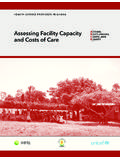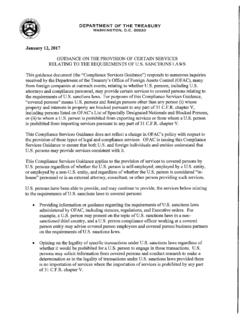Transcription of Social issues in the provision and pricing of water servic.
1 Social issues in the provision and pricing of water services FOREWORD. This book explores the links between Social issues and the provision of water supply and sanitation services in OECD countries. The main focus of the report is the affordability of water services, as well as the Social measures currently in place aimed at resolving these affordability problems. The report also examines the potential role of the private sector in incorporating the Social dimension into water pricing decisions, as well as issues related to making the transition towards higher levels of access to water services. Several external consultants participated in the project and/or drafted parts of the original text. In particular, contributions are gratefully acknowledged from: Paul Herrington, University of Leicester, Leicester, United Kingdom (measuring affordability in Chapter 2; tariff and non-tariff Social measures in Chapter 3).
2 Ana-Mari Hamada, Eduard Interwies, and Andreas Kraemer, ECOLOGIC, Berlin, Germany (private sector participation and regulatory oversight in Chapter 4). Peter Newborne, Overseas Development Institute, London, United Kingdom (managing the transition to improved water services through a differentiated approach in Chapter 5 and contributions to Chapter 6 on Mexico). Lilian Saade-Hazin, private consultant, Oostende, Belgium (case study on Mexico in Chapter 6). The project was carried out under the Natural Resources Management Programme of the OECD Environment Policy Committee. It was managed by Kumi Kitamori (Environment Directorate, OECD), under the guidance of Tom Jones (Environment Directorate, OECD) and the Working Party on Global and Structural Policies. The active support of delegates to that Working Party, as well as that of participants in an expert workshop (OECD Headquarters, November 20, 2002) are also gratefully acknowledged.
3 The project also benefited from the advice and suggestions of Henri Smets (Acad mie de l'Eau) and Bernard Barraqu (Ecole Nationale des Ponts et Chauss es). Rebecca Brite provided editorial support. The project could not have been completed without the financial support received from the governments of Canada and Germany. The report is published under the responsibility of the Secretary-General. 1. TABLE OF CONTENTS. EXECUTIVE CHAPTER 1. INTRODUCTION ..15. CHAPTER 2. MEASURING THE AFFORDABILITY OF HOUSEHOLD water CHAPTER 3. Social MEASURES FOR HOUSEHOLD water CHARGES: BALANCING. ENVIRONMENTAL AND Social CHAPTER 4. GOVERNANCE AND PRIVATE SECTOR PARTICIPATION ..103. CHAPTER 5. MANAGING THE TRANSITION TO IMPROVED water CHAPTER 6. IMPROVING ACCESS TO water SERVICES: MEXICO ..153. CHAPTER 7. SUMMARY AND CONCLUSIONS ..183. ANNEX A. DATA SOURCES FOR CHAPTERS 2 AND 3 ..191.
4 ANNEX B. OPERATION OF FLANDERS-TYPE HOUSEHOLD TARIFF, INCLUDING FREE. ALLOWANCES PER CAPITA ..197. BIBLIOGRAPHY ..201. 2. Executive Summary water pricing policies This book examines Social issues related to the provision and pricing of household water services. can contribute to Properly designed water management policies can contribute to both environmental and economic environmental and goals, but may face resistance due to the perceived negative Social impacts for some stakeholders. economic goals, but Given the importance of household water supply and sanitation services for Social welfare, these may face Social Social dimensions need to be taken into account when key policy decisions are made regarding the resistance. provision of water services. Some basic Social Social issues in the provision of water services can be considered from the perspectives of the concepts in water impact of policies on different income groups; different consumer types; different regions; or services provision different generations.
5 Include . While the Social and public health requirements of access to public water supply have largely access been fulfilled in OECD countries, some still have as many as a quarter of their population without individual household connection to piped supply. As for wastewater collection and treatment, several OECD countries have a backlog of investment requirements, with the result that they still do not meet their own water quality standards. and affordability. Affordability is the Social aspect of water service provision that is most clearly and closely linked to pricing policies. Affordability of water services may not be distributed equally across income groups or neighbourhoods - a lower income household will inevitably pay a higher proportion of their income for water services than a higher income household does. Many OECD Many OECD countries have seen a real increase in household water charges in recent years.
6 The countries have seen factors behind this trend include continuing pollution of water sources (necessitating more water charges expensive treatment), combined with additional national legislation and EU directives that require increase recently, higher standards of wastewater treatment. This trend toward higher prices is likely to continue, and which will continue will therefore continue to generate pressure on the perceived affordability of water services. to put pressure on the affordability of water services. The affordability of There are several methods available for measuring the affordability of water charges. water in about half of "Macro-affordability" indicators are developed by relating national average household water OECD countries is charges to either average household income (disposable or gross) or average household either an issue now, aggregate expenditure.
7 Micro-affordability" indicators disaggregate the former by income groups, or will become one family types or regions. Available evidence of affordability indicators suggests that, in about half the in the future. OECD countries (15 out of 30), affordability of water charges for low-income households is either a significant issue now or might become one in the future, if appropriate policy measures are not put in place. The trade-offs between efficiency and equity objectives in the provision of household water services typically occur when moving from an unmeasured to metered charging structure, when rebalancing tariffs away from fixed charges towards volumetric charges, and when increasing fees and tariffs towards full-cost pricing . There is considerable experience in OECD countries with policy measures to address water affordability for vulnerable groups, while attempting to make water pricing reveal the full economic and environmental costs of water services.
8 Affordability Affordability measures can be classified in two main groups: income support measures and measures can be tariff-related measures. The income support measures address the individual customer's ability to broadly classified pay from the income side (through income assistance, water services vouchers, tariff rebates and into income support discounts, bill re-phasing and easier payment plans, arrears forgiveness). measures . 3. and tariff-related Tariff-related measures keep the size of water bills low for certain groups ( refinement of measures. increasing-block tariffs, tariff choice, tariff capping). There seems to be clear potential benefits from increasing block tariff structure, which adjusts a free or very low-priced first block by household size, and then reflects the transition form basic to discretionary water use in subsequent blocks at prices closer to marginal Social costs.
9 There is evidence that the use of such tariffs is increasing. Co-operation While the provision of urban water supply and sanitation is traditionally considered a public between the public service, there is a trend of increasing commercialisation and private sector participation (PSP), for and private sectors a number of reasons. Whether water services are provided by the public or private sector (or in the provision of both), it is important that Social and environmental objectives continue to be met. water services is expanding. OECD countries already use several different forms of Different types and degrees of PSP in household water services are found in OECD countries. private sector These can be characterised as Administrative PSP, Corporative PSP, Legal PSP and Financial participation (PSP). PSP, according to legal status, asset ownership, operation and management, and capital investment responsibility.
10 Several examples of different forms of PSP are included in this book. These examples illustrate how these water service providers are being regulated in the areas of pricing , service standards, operational efficiency, investment practices, water quality, environmental protection, and consumer protection. Some key criteria for evaluating the effectiveness of water service providers in meeting economic, Social , and environmental objectives are also considered. There are OECD Access to public water supplies is no longer a serious problem in most OECD countries, countries where the (especially in urban areas), with at least 75% of the population (and often as high as 90%) already extent of coverage of being served. Thus, the Social and public health requirements for universal access have largely water services been fulfilled. However, in a few OECD countries or regions, the extent of coverage of water remains incomplete.
















